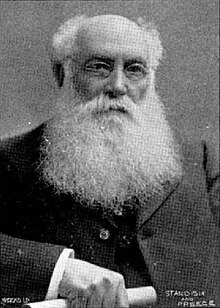Samuel Farr (architect)
| Samuel Farr | |
|---|---|

Samuel Farr ca 1900
|
|
| Born | 1827 Baldock, North Hertfordshire, England |
| Died | 14 July 1918 Christchurch, New Zealand |
| Nationality | New Zealand |
| Occupation | Architect |
| Buildings |
Cranmer Court St Paul's Church |
Samuel Charles Farr (1827 – 14 July 1918) was a 19th-century builder and architect in Christchurch, New Zealand. He intended to emigrate from England to Auckland, but significant shipping problems saw him end up in Akaroa in 1850 instead. From 1862, he lived in Christchurch. Farr has a number of firsts against his name: the first marriage in Canterbury, he designed Akaroa's first church, designed New Zealand's first iron verandahs, and he started Sunday schools in Canterbury. As a leading member of the Acclimatisation Society, he stocked almost every lake and river in Canterbury with fish and was instrumental in introducing the bumblebee to New Zealand. His most notable building is Cranmer Court, the former Normal School, in the Christchurch Central City; this building is to be demolished following the February 2011 Christchurch earthquake.
Farr was born in Baldock, North Hertfordshire, England, in 1827. He was the son of a builder and was exposed to architecture through observing his father's work, but he did not receive formal training, which required working for an architect for four years. In 1849, Mary Ann Pavitt from Theydon Garnon visited friends in Baldock for a farewell, as she was to emigrate with her family to New Zealand. Farr and Pavitt fell in love and became engaged. She was the oldest daughter of John and Elizabeth Pavitt.
The Pavitt family and Farr left London on 19 November 1849, in the barque The Monarch for Auckland. On 5 March 1860, while The Monarch was crossing the Tasman Sea in a heavy gale, her rudder was carried away. The vessel drifted with the wind to the south of Stewart Island, and it took a fortnight to get a temporary rudder installed. The Monarch then made its way up the east coast of the South Island, but a week later the new rudder was carried away and was lost. On 2 April 1850, The Monarch managed to reach Akaroa, and there 41 passengers, including Farr, decided to remain.
...
Wikipedia
